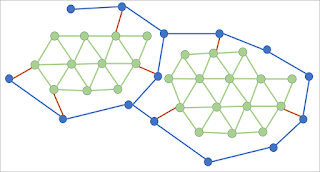 |
| Figure 1 |
- http://pumpkinstrokemarrow.blogspot.co.uk/. 1,800 posts. October 2006 to October 2012
- http://psmv2.blogspot.co.uk/. 2,000 posts. October 2012 to February 2016
- http://psmv3.blogspot.co.uk/. 2,100 posts. February 2016 to May 2018 (active)
- http://psmv4.blogspot.co.uk/. Not yet active
- http://psmv5.blogspot.co.uk/. Not yet active
The blue and grey tree structure, organised by month within year, displayed on the right on the two more recent blogs is helpful. By clicking to expand and contract, one can often find what one is looking for by post title. But this does not always work, my custom being to use short titles which seem neat at the time, but which may not be very informative later. While in the oldest blog, history is displayed by month on the left, with no expansion to post, which is not so helpful.
 |
| Figure 2 |
So far there have been four of these search keys, moving from one to the next when there has been some important shift, development or change of direction.
The four groups
Sometimes referred to as the four series, thus accounting for the form of the keys used below.
 |
| Figure 3 |
Sra
- 10 posts
- 20161231 to 20170317
- Early thoughts about organising what came to be called the local or layered workspace (LWS, in contrast to Baars’ well known global workspace theory, GWS). A structure made up of a small number of layers, each consisting of a large array of cells, after the fashion of an Excel worksheet, illustrated at Figure 3. Soft centred patterns. Layers, layer objects and column objects. Seeing rectangles. Seeing red.
- 6 posts
- 20170328 to 20170428
- A regrouping, having bumped into various technical problems. Exploring various ways of coding data on our two-dimensional arrays of real valued cells. The use of layers to code up complex scenes – like a second world war battleship at sea. Parts of objects and their labels.
- 9 posts
- 20170521 to 20170802
- Layers with velocity, to accommodate a steady movement across or of the visual field. Scenes, takes and frames. Background, foreground and other objects. Using high and low valued cells to define parts and their shapes instead of soft centred patterns. Column objects, composite objects and sequence objects. Sinks and sources. Statements of rules.
- 11 posts (including this one)
- 20170904 to 20180524
- The move from the Excel workbook flavoured LWS-W to the neuron flavoured LWS-N. Triangulations of surfaces and shapes. Texture nets and shape nets. Coding music.
 |
| Figure 4 |
Some key points
One part of this work is about trying to draw meaning out of the void, to update the first words of the book of Genesis, where the Lord was just starting work on an earth which was at that point just welter and waste and when there was darkness over the deep. In the sense that our LWS is self contained and by definition, it cannot draw its meaning from elsewhere, from anywhere else, it has to have meaning of itself. How do we do that, starting from an empty data store? Thinking of LWS-N in particular, how do we organise the linkages of neurons to code up for ‘War and Peace’, the elephant in the room – or even something as apparently straightforward as a patch of red?
Another part is thinking about how that content, that meaning might be projected from the active, physical matter of the brain into the metaphysical matter of our subject experience.
Yet another part is putting LWS in context. How it fits into the brain and body. Into the evolution and development of same. Into all the work on consciousness and unconsciousness done elsewhere, by others.
Listings
The eleven posts of the ‘srd’ series
http://psmv3.blogspot.co.uk/2017/09/sensing-spheroids.html
http://psmv3.blogspot.co.uk/2017/09/coding-for-colour.html
http://psmv3.blogspot.co.uk/2017/09/geometry-and-activation-in-world-of.html
http://psmv3.blogspot.co.uk/2017/09/scoring-for-music.html
http://psmv3.blogspot.co.uk/2017/10/on-taxonomy-of-consciousness.html
http://psmv3.blogspot.co.uk/2017/11/a-dogs-life-reprised.html
http://psmv3.blogspot.co.uk/2018/01/an-introduction-to-lws-n.html
http://psmv3.blogspot.co.uk/2018/03/more-animal-game.html
http://psmv3.blogspot.co.uk/2018/03/descriptors.html
http://psmv3.blogspot.co.uk/2018/05/a-modest-change-to-layer-objects-of-lws.html
http://psmv3.blogspot.co.uk/2018/05/an-update-on-seeing-red-rectangles.html
The nine posts of the ‘src’ series
http://psmv3.blogspot.co.uk/2017/05/recap-on-our-data-structure.html
http://psmv3.blogspot.co.uk/2017/05/in-praise-of-homunculus.html
http://psmv3.blogspot.co.uk/2017/06/on-scenes.html
http://psmv3.blogspot.co.uk/2017/06/on-elements.html
http://psmv3.blogspot.co.uk/2017/07/binding.html
http://psmv3.blogspot.co.uk/2017/07/rules-episode-one.html
http://psmv3.blogspot.co.uk/2017/07/rules-episode-two.html
http://psmv3.blogspot.co.uk/2017/07/rules-supplemental.html
http://psmv3.blogspot.co.uk/2017/08/occlusion.html
The six posts of the ‘srb’ series
http://psmv3.blogspot.co.uk/2017/03/a-new-start.html
http://psmv3.blogspot.co.uk/2017/04/shapes-not-numbers.html
http://psmv3.blogspot.co.uk/2017/04/its-chips-life.html
http://psmv3.blogspot.co.uk/2017/04/more-on-modes.html
http://psmv3.blogspot.co.uk/2017/04/a-ship-of-line.html
http://psmv3.blogspot.co.uk/2017/04/on-parts-and-properties.html
The ten posts of the ‘sra’ series
http://psmv3.blogspot.co.uk/2016/12/from-grids-to-objects.html
http://psmv3.blogspot.co.uk/2017/01/expressions-and-their-orders.html
http://psmv3.blogspot.co.uk/2017/01/lines.html
http://psmv3.blogspot.co.uk/2017/01/layers-and-columns.html
http://psmv3.blogspot.co.uk/2017/02/restatement-of-hypothesis.html
http://psmv3.blogspot.co.uk/2017/03/on-seeing-rectangles.html
http://psmv3.blogspot.co.uk/2017/03/soft-centred-patterns.html
http://psmv3.blogspot.co.uk/2017/03/activation-revisited.html
http://psmv3.blogspot.co.uk/2017/03/seeing-red-rectangles.html
http://psmv3.blogspot.co.uk/2017/03/coding-for-red-and-other-stuff.html
References
Reference 1: http://psmv3.blogspot.co.uk/2017/03/seeing-red-rectangles.html.
Reference 2: Seeing Red: A Study in Consciousness - Nicholas Humphrey - 2009.
Reference 3: http://psmv3.blogspot.co.uk/2018/01/an-introduction-to-lws-n.html. Perhaps as good place as any to start. The seventh post in the ‘srd’ series.
Group search key: srd.
No comments:
Post a Comment